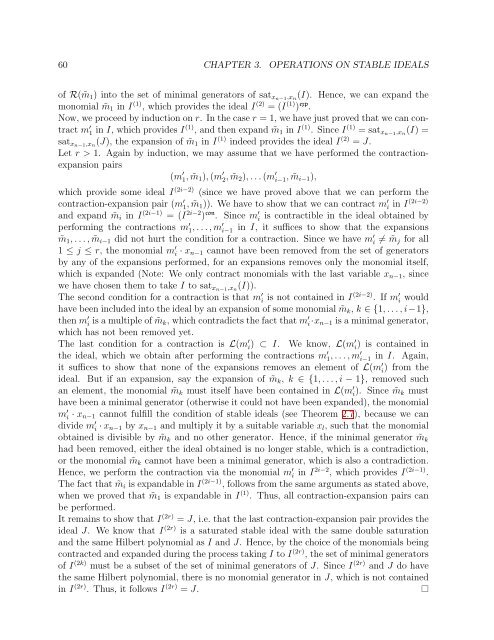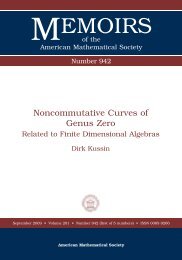University of Paderborn Department of Mathematics Diploma Thesis ...
University of Paderborn Department of Mathematics Diploma Thesis ...
University of Paderborn Department of Mathematics Diploma Thesis ...
Create successful ePaper yourself
Turn your PDF publications into a flip-book with our unique Google optimized e-Paper software.
60 CHAPTER 3. OPERATIONS ON STABLE IDEALS<strong>of</strong> R( ˜m 1 ) into the set <strong>of</strong> minimal generators <strong>of</strong> sat xn−1 ,x n(I). Hence, we can expand themonomial ˜m 1 in I (1) , which provides the ideal I (2) = (I (1) ) exp .Now, we proceed by induction on r. In the case r = 1, we have just proved that we can contractm ′ 1 in I, which provides I (1) , and then expand ˜m 1 in I (1) . Since I (1) = sat xn−1 ,x n(I) =sat xn−1 ,x n(J), the expansion <strong>of</strong> ˜m 1 in I (1) indeed provides the ideal I (2) = J.Let r > 1. Again by induction, we may assume that we have performed the contractionexpansionpairs(m ′ 1, ˜m 1 ), (m ′ 2, ˜m 2 ), . . . (m ′ i−1, ˜m i−1 ),which provide some ideal I (2i−2) (since we have proved above that we can perform thecontraction-expansion pair (m ′ 1, ˜m 1 )). We have to show that we can contract m ′ i in I (2i−2)and expand ˜m i in I (2i−1) = (I 2i−2 ) con . Since m ′ i is contractible in the ideal obtained byperforming the contractions m ′ 1, . . . , m ′ i−1 in I, it suffices to show that the expansions˜m 1 , . . . , ˜m i−1 did not hurt the condition for a contraction. Since we have m ′ i ≠ ˜m j for all1 ≤ j ≤ r, the monomial m ′ i · x n−1 cannot have been removed from the set <strong>of</strong> generatorsby any <strong>of</strong> the expansions performed, for an expansions removes only the monomial itself,which is expanded (Note: We only contract monomials with the last variable x n−1 , sincewe have chosen them to take I to sat xn−1 ,x n(I)).The second condition for a contraction is that m ′ i is not contained in I (2i−2) . If m ′ i wouldhave been included into the ideal by an expansion <strong>of</strong> some monomial ˜m k , k ∈ {1, . . . , i−1},then m ′ i is a multiple <strong>of</strong> ˜m k , which contradicts the fact that m ′ i·x n−1 is a minimal generator,which has not been removed yet.The last condition for a contraction is L(m ′ i) ⊂ I. We know, L(m ′ i) is contained inthe ideal, which we obtain after performing the contractions m ′ 1, . . . , m ′ i−1 in I. Again,it suffices to show that none <strong>of</strong> the expansions removes an element <strong>of</strong> L(m ′ i) from theideal. But if an expansion, say the expansion <strong>of</strong> ˜m k , k ∈ {1, . . . , i − 1}, removed suchan element, the monomial ˜m k must itself have been contained in L(m ′ i). Since ˜m k musthave been a minimal generator (otherwise it could not have been expanded), the monomialm ′ i · x n−1 cannot fulfill the condition <strong>of</strong> stable ideals (see Theorem 2.7), because we candivide m ′ i · x n−1 by x n−1 and multiply it by a suitable variable x l , such that the monomialobtained is divisible by ˜m k and no other generator. Hence, if the minimal generator ˜m khad been removed, either the ideal obtained is no longer stable, which is a contradiction,or the monomial ˜m k cannot have been a minimal generator, which is also a contradiction.Hence, we perform the contraction via the monomial m ′ i in I 2i−2 , which provides I (2i−1) .The fact that ˜m i is expandable in I (2i−1) , follows from the same arguments as stated above,when we proved that ˜m 1 is expandable in I (1) . Thus, all contraction-expansion pairs canbe performed.It remains to show that I (2r) = J, i.e. that the last contraction-expansion pair provides theideal J. We know that I (2r) is a saturated stable ideal with the same double saturationand the same Hilbert polynomial as I and J. Hence, by the choice <strong>of</strong> the monomials beingcontracted and expanded during the process taking I to I (2r) , the set <strong>of</strong> minimal generators<strong>of</strong> I (2k) must be a subset <strong>of</strong> the set <strong>of</strong> minimal generators <strong>of</strong> J. Since I (2r) and J do havethe same Hilbert polynomial, there is no monomial generator in J, which is not containedin I (2r) . Thus, it follows I (2r) = J.
















